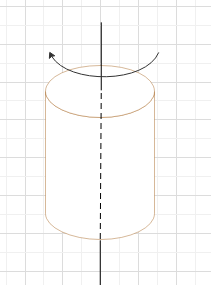Question
Question: Torques of equal magnitude are applied to hollow cylinders and a solid sphere, both having the same ...
Torques of equal magnitude are applied to hollow cylinders and a solid sphere, both having the same mass and radius. The cylinder is free to rotate about its standard axis of symmetry, and the sphere is free to rotate about its axis passing through its centre. Which of the two will acquire a greater angular speed after a given time.
Solution
Hint: Use the formula τ=Iα and find and compare the angular acceleration of both the given bodies. The moment of inertias of hollow cylinder and the solid sphere about the given axes of rotation are I1=MR2 and I2=52MR2 respectively. Then use the formula ω=ω0+αt and compare the angular velocities of both the bodies at a given time t.
Formula used:
τ=Iα
ω=ω0+αt
Complete step by step answer:
When a torque is applied to a body, it creates an angular acceleration of the body about the axis of rotation.
If the τ is the torque applied and α is the angular acceleration of the body, then
τ=Iα, where I is the moment of inertia of the body about the axis of rotation.
Moment of inertia is analogous to mass of the body in translation motion.
It is given that equal torques are applied to a hollow cylinder and a solid sphere. This will create angular accelerations in both the bodies.
Let I1 and α1 be the moment of inertia and angular acceleration of the hollow cylinder about its standard axis of symmetry.

Therefore,
τ=I1α1
The moment of inertia of a hollow cylinder about its axis of symmetry is given as I1=MR2 ⇒τ=MR2α1
⇒α1=MR2τ …… (i).
Let I2 and α2 be the moment of inertia and angular acceleration of the solid sphere about an axis passing through its centre.

Therefore,
τ=I2α2
The moment of inertia of a solid sphere about an axis passing through its centre is given as I2=52MR2
⇒τ=52MR2α2
⇒α2=2MR25τ=2.5MR2τ …… (ii).
From equations (i) and (ii) we get that α2>α1.
When the body has some angular acceleration, the angular velocity about the same axis changes with time.
For constant angular acceleration, ω=ω0+αt
Here, ω is the angular velocity of the body at an instant of time t and ω0 is the angular velocity of the body at time t=0.
Let us assume that both the bodies were at rest at time t=0 and they undergo constant angular acceleration.
Let ω1 and ω2 be the angular velocities of the two bodies at a given time t.
Then we get,
ω1=α1t
And
ω2=α2t
But we know that α2 > α1.
Hence, ω2 > ω1.
Hence, the solid sphere will acquire a greater angular speed after a given time.
Note: Torque is analogous to force. When a torque is generated on a rigid body, the body undergoes a rotational motion. The body will rotate about the fixed axis of rotation (the line to which the body is hinged). If the body is not hinged to any axis, then it will move about an axis passing through its centre of mass.
We know that in translation motion, when an unbalanced force is applied on a point sized mass, the force makes the body accelerate. And from Newton’s second law of motion, we know that F=ma, where F is the force applied, m is the mass and a is the acceleration of the mass.
